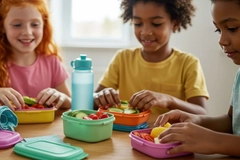Baby food packaging labels leave parents confused, finds fruit and veg investigation

08 Feb 2021 --- There is a “disconnect” between front-of-pack labels (FoPL) and ingredient lists of foods containing fruits and vegetables, according to a new US study. These package labels can make it difficult for parents to understand what they are feeding their young children.
The researchers are emphasizing how nutrition educators and healthcare professionals can help parents navigate the marketplace.
“Our hope is that nutrition educators will note differences between the ingredients list and the front label of the package. Many parents use the front of the package to decide on their purchases,” says Dr. Mackenzie Ferrante of Colorado State University’s department of food science and human nutrition.
“We want the front of the packages - where vegetables might be listed - to accurately represent the primary ingredients, and even the flavor, of the product,” adds Dr. Susan Johnson, department of pediatrics, section of nutrition, University of Colorado Anschutz Medical Campus.
She also wants more transparency so parents and caregivers can buy the food they want their children to learn to eat at the family table. “Let’s make it easier for them to do that,” says Johnson. The research goal is to help parents understand how FoPL indicate the contents of infant and toddler foods.
The research goal is to help parents understand how FoPL indicate the contents of infant and toddler foods.
Reflecting fruit and vegetable contents
In the investigation, now published in the Journal of Nutrition Education and Behavior, the researchers examined aspects of vegetables and fruits contributing to the ingredient lists of infant and toddler products.
For example, they reviewed whether the vegetable or the fruit in the product was a puree or a powder. They also examined where it was listed among the ingredients and product name.
They found that vegetables in the US Department of Agriculture’s dark green category were more likely to appear in product names. Other vegetables and fruit forms were also associated with inclusion in the product name. However, juice and juice concentrates were less likely to be included in names.
Inconsistent information
The researchers say the findings demonstrate that inconsistent information exists on some commercial infant and toddler food packages. Food preferences develop early for children by exposure to flavors. Therefore, parents can improve their children’s lifelong health via better nutrition as infants and toddlers.
FoPL have been a hot topic within the children’s nutrition sector. The US House of Representatives’ investigative committee is calling for baby food companies to include levels of heavy metals on food labels.
Another US study recently found that moving nutritional labeling from the back to the front of food packaging may incentivize food producers to competitively improve the quality of their ingredients throughout market categories.
Edited by Katherine Durrell












